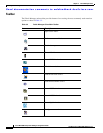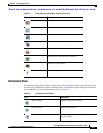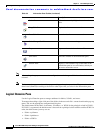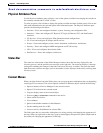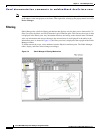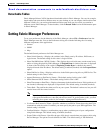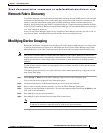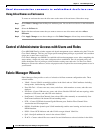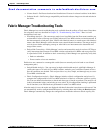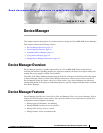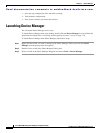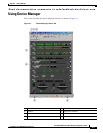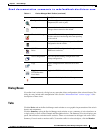
Send documentation comments to mdsfeedback-doc@cisco.com.
3-16
Cisco MDS 9000 Family Fabric Manager Configuration Guide
OL-6965-03, Cisco MDS SAN-OS Release 2.x
Chapter 3 Fabric Manager Client
Control of Administrator Access with Users and Roles
Using Alias Names as Enclosures
To create an enclosure that uses the alias name as the name of the enclosure, follow these steps:
Step 1 Select Hosts or Storage from the Physical Attributes pane. You see the list of devices in the Information
pane.
Step 2 Select the NxPorts tab.
Step 3 Right-click the enclosure names that you want to convert to use alias names and select Alias >
Enclosure.
Step 4 Click Apply Changes to save these changes or click Undo Changes to discard any unsaved changes.
Control of Administrator Access with Users and Roles
Cisco MDS 9000 Family switches support role-based management access whether using the CLI or the
Cisco Fabric Manager. This lets you assign specific management privileges to particular roles and then
assign one or more users to each role.
Cisco Fabric Manager uses SNMPv3 to establish role-based management access. After completing the
setup routine, a single role, user name, and password are established. The role assigned to this user
allows the highest level of privileges, which includes creating users and roles. Use the Cisco Fabric
Manager to create roles and users, and to assign passwords as required for secure management access in
your network.
Fabric Manager Wizards
Fabric Manager client provides a series of wizards to facilitate common configuration tasks. These
wizards include:
• VSAN—Creates VSANs on multiple switches in the fabric and sets VSAN attributes including
interop mode, load balancing, and FICON.
• Zone Edit Tool —Creates zone sets, zones, and aliases. Adds members to zones, and edits zone
database.
• IVR Zone—Creates IVR zone sets, zones, and aliases. Enables IVR NAT and auto-topology. Adds
members to IVR zones, and edits IVR zone database.
• PortChannel—Creates PortChannels from selected ISLs either manually or automatically. Sets
PortChannel attributes like channel ID and trunking mode.
• FCIP —Creates FCIP links between Gigabit Ethernet ports. Enables Fibre Channel Write
Acceleration and IP compression
• DPVM—Establishes dynamic port VSAN membership, enables auto learning, and activates the
DPVM database.
• iSCSI—Zones iSCSI initiators and adds VSAN to target allowed VSAN list.
• QoS—Sets QoS attributes for zones in the selected VSAN.
• IP ACL—Creates ordered IP access control lists and distributes to selected switches in the fabric.



